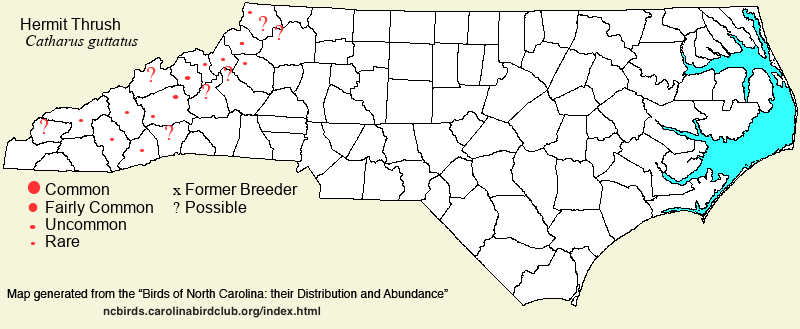 |  |
|
Hermit Thrush - Catharus guttatus TURDIDAE Members: | Search Common: Search Scientific: |
|
|
|||||||
| General Comments | The Hermit Thrush is the only Catharus thrush that winters in the United States, even though several other species in that genus are reported (likely incorrectly) in the state in winter every few years. However, like others in the genus it breeds across most of the boreal forest zone of Canada and south through the Rockies and much of the Appalachians. In North Carolina, it was first noted in summer in the late 1970's, and now it occurs in summer in nearly all of the spruce-fir zones, though total numbers are still small. Why such a species would be clearly moving south, in the face of "global warming", is unclear. It winters over all of the state, and numbers seem to be slightly increasing, probably owing to warmer winters in the past few decades. At this season, it requires some or much evergreen cover in forests, most often broadleaf evergreens, such as American Holly, Redbay, Wild Olive, gallberries, and even Chinese Privet -- these species also have berries that are ripe in winter and thus not only provide cover but food, as well. | ||||||
| Breeding Status | Breeder | ||||||
| NC BRC List | Definitive | ||||||
| State Status | SR | ||||||
| U.S. Status | |||||||
| State Rank | S3B,S5N | ||||||
| Global Rank | G5 | ||||||
| Coastal Plain | Winter resident. Formerly fairly common, but now common over the eastern half of the region, and fairly common in the western portions. Mainly mid-Oct to late Apr, rarely into early May. Peak counts: | ||||||
| Piedmont | Winter resident. Fairly common over the southeastern half or two-thirds of the province, but uncommon in the northwestern and foothills portions. An increase in numbers in the past few decades, though not quite common anywhere in the region. Mainly mid-Oct to very late Apr. Peak counts: | ||||||
| Mountains | Summer resident at high elevations, and winter resident throughout. In summer, uncommon to locally fairly common and increasing in the spruce-fir zone down to about 5,000 feet; occurs as far southwest as Great Smoky Mountains NP. However, one singing on Hooper Bald (Graham) on 13 Jun 2020 is west of the known breeding range. Now beginning to nest in mixed hardwood-spruce stands and rarely even in pure hardwoods, down to at least 4,400 feet. Suspected breeding in the state was finally confirmed by location of an active nest at Bald Knob (Yancey) in Jul 2011 [Chat 75:137-146 link]; several additional nesting records have been obtained in recent years. Otherwise, uncommon winter resident in the lower and middle elevations, becoming somewhat scarce by late winter. Mainly mid-Oct to late Apr or early May. Peak counts: 68 singing birds in late May 2016 on the Black Mountains Spring Bird Count; 30 along a single road [Wilson Boundary Road], Yancey, 2 Jun 2017. | ||||||
| Finding Tips |
This species is reasonably easy to find in winter in forests near the coast that have much broadleaf evergreen cover. Places such as Alligator River NWR and Mattamuskeet NWR are good. In summer, a few should be heard in Mount Mitchell SP, Roan Mountain close to the Appalachian Trail, Grandfather Mountain, and Clingman's Dome. Most stands of spruce-fir now have the species as a breeder. *** to **** | ||||||
| Attribution | LeGrand[2023-03-28], LeGrand[2021-08-04], LeGrand[2020-10-21] | ||||||
| NC Map Map depicts all counties with a report (transient or resident) for the species. | Click on county for list of all known species. |
| NC Breeding Season Map Map depicts assumed breeding season abundance for the species. |  |